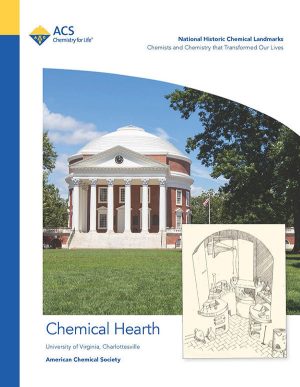FOR IMMEDIATE RELEASE

WASHINGTON, Feb. 22, 2024 — Chemistry education has come a long way since the first U.S. universities were founded. That progress is due in part to innovations introduced during the 19th century in a teaching laboratory at the University of Virginia (UVA). The American Chemical Society (ACS) will designate the site — which is believed to be the oldest remaining example of a hands-on laboratory for teaching chemistry in the U.S. — as a National Historic Chemical Landmark during a March 1 ceremony at the Charlottesville campus.
The March 1 Landmark dedication ceremony will be held from 2 to 5 p.m. EST at UVA. The program will feature remarks by speakers, including Carroll; Brian Hogg, senior historic preservation planner in UVA’s Office of the Architect; and Jill Venton, chair of the UVA Chemistry Department.
“The content of chemistry courses has changed considerably over the past 200 years as scientists have learned more about the properties and behavior of matter,” says ACS President Mary K. Carroll, who is an award-winning chemistry professor at Union College. “But the importance of engaging students in hands-on laboratory experiences, first championed by a few progressive institutions, including UVA, has stood the test of time. We are excited to honor the university for its role in advancing this effective and impactful approach to teaching science.”
In the early 19th century, most laboratories in the U.S. were located in private homes. But labs were also gradually being introduced in universities as learning spaces for young adults. However, hands-on experiments for students were rare, since lab apparatus was expensive and often had to be imported from Europe. So students typically would only watch demonstrations.
That began to change as instructors realized their students’ skills would improve if they could carry out the procedures themselves. When UVA’s first professor of natural history, John Patten Emmet, arrived on campus in 1825, he championed this type of instruction.
Emmet was assigned spaces for a chemistry lab and lecture hall in the Rotunda, one of the original campus buildings. It had been designed by Thomas Jefferson, the university’s founder and a former U.S. president. Emmet consulted with Jefferson on the layout and equipment for the two rooms. A workspace based on Emmet’s design, where students could conduct experiments at high temperatures, was built in the Rotunda. It included a structure known as a chemical hearth — an integrated fireplace that probably burned wood or charcoal.
The university moved the laboratory to another location in 1841-42, and the chemical hearth was bricked up and forgotten until preparations for a Rotunda restoration unearthed it in 2013. Now, an estimated 200,000 visitors see the restored hearth every year during the university’s campus tours.
###
The American Chemical Society (ACS) is a nonprofit organization chartered by the U.S. Congress. ACS’ mission is to advance the broader chemistry enterprise and its practitioners for the benefit of Earth and all its people. The Society is a global leader in promoting excellence in science education and providing access to chemistry-related information and research through its multiple research solutions, peer-reviewed journals, scientific conferences, eBooks and weekly news periodical Chemical & Engineering News. ACS journals are among the most cited, most trusted and most read within the scientific literature; however, ACS itself does not conduct chemical research. As a leader in scientific information solutions, its CAS division partners with global innovators to accelerate breakthroughs by curating, connecting and analyzing the world’s scientific knowledge. ACS’ main offices are in Washington, D.C., and Columbus, Ohio.
ACS established the National Historic Chemical Landmarks program in 1992 to recognize seminal events in the history of chemistry and to increase awareness of the contributions of chemistry to society. Past Landmarks include the invention of Polaroid instant photography, the discovery and production of penicillin, the invention of synthetic plastics, and the works of such notable scientific figures as educator George Washington Carver and environmentalist Rachel Carson. For more information, visit www.acs.org/landmarks.
To automatically receive press releases from the American Chemical Society, contact newsroom@acs.org.
Note: ACS does not conduct research, but publishes and publicizes peer-reviewed scientific studies.

